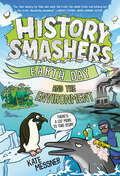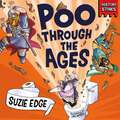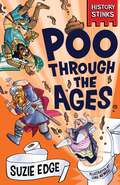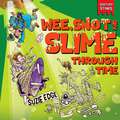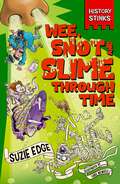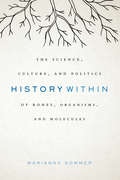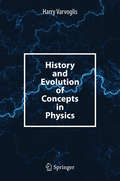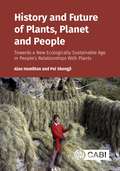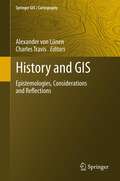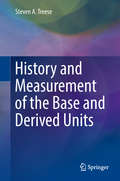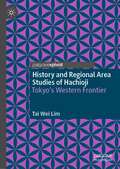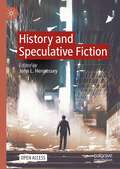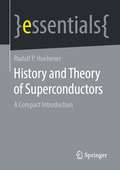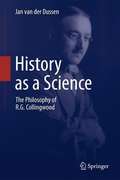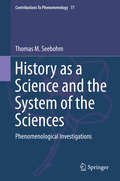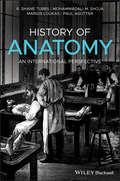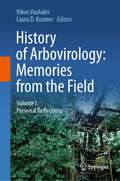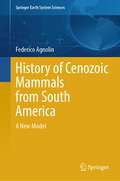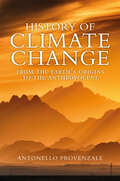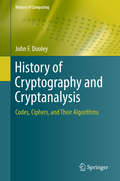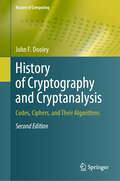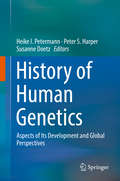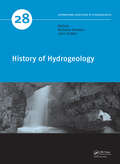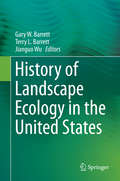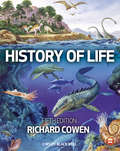- Table View
- List View
History Smashers: Earth Day and the Environment (History Smashers)
by Kate MessnerMyths! Lies! Recycling scams? Discover the real story behind the first Earth Day celebration and some of the biggest US climate catastrophes--and their solutions! Don't miss the award-winning History Smashers series as they get to the truth on the biggest environmental fibs!In April 1970, twenty million people grabbed their rakes, gloves, and recycling bins to celebrate the first Earth Day. Since that environmental kickoff, nature has never been in better shape. RIGHT?WRONG! The real deal is a bit muddier than that. It&’s true that the first Earth Day encouraged people around the globe to clean up their act when it came to the environment. But activists have been working for centuries to save the planet! Native people across the world developed sustainable farming practices, women in eighteenth-century India stood up to protect trees, and amateur scientist Eunice Foote discovered the science behind global warming all the way back in the 1850s!Join the History Smashers team to bust history's biggest misconceptions and figure out what in the world really went down before (and after!) the first Earth Day—and how you can join the fight to protect the environment.Ready to bust new myths? Check out more titles in the History Smashers series: The Mayflower • Plagues & Pandemics • The Titanic • The Underground Railroad • The Salem Witch Trials
History Stinks!: Poo Through the Ages (History Stinks!)
by Suzie EdgeWhat's that smell? It's HISTORY - and it STINKS!Did you know that you can discover loads about history just from the loo? Or piles about the past just from a poo? If not, then get ready to discover everything from Henry VIII's dodgy diet and poo-tastic Roman plumbing, to the stinky secrets of Victorian sewers and how life, death and everything in between can hang on the humble number two.From Saxons and Tudors to Ancient Greece, the Indus Valley, Aztecs and beyond, Poo Through the Ages features mighty monarchs, bonkers battles, deadly diseases, fossilised faeces and poo, poo, poo. Packed with fascinating facts, hilarious illustrations and the smelliest stories from our pongy past, get ready to dive into the smelliest corners of history!
History Stinks!: Poo Through the Ages (History Stinks!)
by Suzie EdgeWhat's that smell? It's HISTORY - and it STINKS!Did you know that you can discover loads about history just from the loo? Or piles about the past just from a poo? If not, then get ready to discover everything from Henry VIII's dodgy diet and Aztec poop canoes to giant, fossilizsed Viking plops, poo-tastic Roman plumbing, the stinky secrets of Victorian sewers, smelly cesspits, medieval muck and more.From Saxons and Tudors to ancient Greece, the Indus Valley and beyond, Poo Through the Ages features mighty monarchs, bonkers battles, deadly diseases, foul-smelling faeces and poo, poo, poo. Packed with fascinating facts, hilarious illustrations and the smelliest stories from our pongy past, get ready to dive into the smelliest corners of history!
History Stinks!: Wee, Snot and Slime Through Time (History Stinks! #2)
by Suzie EdgeWhat's that smell? It's HISTORY - and it STILL STINKS!Did you know that ancient Romans used wee as mouthwash? GROSS! Or that snot was behind some of history's greatest discoveries? HUH?From French kings with boils on their bums to Victorians who liked to catch tears in special bottles, Wee, Snot and Slime Through Time features deadly battlefield diseases, disgusting dukes, beastly bacteria and slimy stories from the Egyptians to the Tudors and beyond.Packed with fascinating facts, hilarious illustrations and the snottiest, wee-tastic tales from our pongy past, get ready to be dunked into the foulest corners of history.
History Stinks!: Wee, Snot and Slime Through Time (History Stinks! #2)
by Suzie EdgeWhat's that smell? It's HISTORY - and it STILL STINKS!Did you know that ancient Romans used wee as mouthwash? GROSS! Or that snot was behind some of history's greatest discoveries? HUH?From French kings with boils on their bums to Victorians who liked to catch tears in special bottles, Wee, Snot and Slime Through Time features deadly battlefield diseases, disgusting dukes, beastly bacteria and slimy stories from the Egyptians to the Tudors and beyond.Packed with fascinating facts, hilarious illustrations and the snottiest, wee-tastic tales from our pongy past, get ready to be dunked into the foulest corners of history.
History Within: The Science, Culture, and Politics of Bones, Organisms, and Molecules
by Marianne SommerPersonal genomics services such as 23andMe and Ancestry.com now offer what once was science fiction: the ability to sequence and analyze an individual's entire genetic code--promising, in some cases, facts about that individual's ancestry that may have remained otherwise lost. Such services draw on and contribute to the science of human population genetics that attempts to reconstruct the history of humankind, including the origin and movement of specific populations. Is it true, though, that who we are and where we come from is written into the sequence of our genomes? Are genes better documents for determining our histories and identities than fossils or other historical sources? Our interpretation of gene sequences, like our interpretation of other historical evidence, inevitably tells a story laden with political and moral values. Focusing on the work of Henry Fairfield Osborn, Julian Sorell Huxley, and Luigi Luca Cavalli-Sforza in paleoanthropology, evolutionary biology, and human population genetics, History Within asks how the sciences of human origins, whether through the museum, the zoo, or the genetics lab, have shaped our idea of what it means to be human. How have these biologically based histories influenced our ideas about nature, society, and culture? As Marianne Sommer shows, the stories we tell about bones, organisms, and molecules often change the world.
History and Evolution of Concepts in Physics
by Harry VarvoglisOur understanding of nature, and in particular of physics and the laws governing it, has changed radically since the days of the ancient Greek natural philosophers. This book explains how and why these changes occurred, through landmark experiments as well as theories that - for their time - were revolutionary. The presentation covers Mechanics, Optics, Electromagnetism, Thermodynamics, Relativity Theory, Atomic Physics and Quantum Physics. The book places emphasis on ideas and on a qualitative presentation, rather than on mathematics and equations. Thus, although primarily addressed to those who are studying or have studied science, it can also be read by non-specialists. The author concludes with a discussion of the evolution and organization of universities, from ancient times until today, and of the organization and dissemination of knowledge through scientific publications and conferences.
History and Future of Plants, Planet and People: Towards a New Ecologically Sustainable Age in People’s Relationships With Plants
by Professor Alan Hamilton Professor Pei ShengjiThis fascinating book presents the experiences and pooled knowledge of two very different conservation scientists; Pei Shengji from Sichuan, China and Alan Hamilton from London, UK. They have been drawn together over many years through working on some of the same conservation projects and have discovered that they overlap in their ideas about the sorts of work that needs to be done and how it can best be carried out. The book describes some of their own experiences, set within the contexts of their varied careers and the development of their thinking. Plant conservation is crucial to the preservation of natural ecosystems, but conventional approaches have met with only limited success. The authors have concluded that plant conservationists need social allies - elements of society that have other primary concerns, but whose efforts, if successful, will bring benefits to plant conservation too. It is the state and condition of plants on the ground that ultimately matter in conserving ecosystems, and therefore it is the role of local people who interact directly with them which enables success. Ethnobotany is a key skill required of practical plant conservationists. Its techniques enable them to explore connections between people and plants, learn about local perspectives and establish relationships with the people upon whom conservation and sustainable development relies. This book: recommends how to advance plant conservation, based on real experiences. will inspire more people to become involved in plant conservation. demonstrates how the very different backgrounds of the authors have influenced the courses of their careers, but have enabled them to come to very similar conclusions about conservation practice. demonstrates the importance of geographically-based biocultural diversity, as a counterbalancing force to globalisation.
History and GIS: Epistemologies, Considerations and Reflections
by Alexander Von Lünen Charles TravisGeographical Information Systems (GIS) - either as "standard" GIS or custom made Historical GIS (HGIS) - have become quite popular in some historical sub-disciplines, such as Economic and Social History or Historical Geography. "Mainstream" history, however, seems to be rather unaffected by this trend. More generally speaking: Why is it that computer applications in general have failed to make much headway in history departments, despite the first steps being undertaken a good forty years ago? With the "spatial turn" in full swing in the humanities, and many historians dealing with spatial and geographical questions, one would think GIS would be welcomed with open arms. Yet there seems to be no general anticipation by historians of employing GIS as a research tool. As mentioned, HGIS are popular chiefly among Historical Geographers and Social and Economic Historians. The latter disciplines seem to be predestined to use such software through the widespread quantitative methodology these disciplines have employed traditionally. Other historical sub-disciplines, such as Ancient History, are also very open to this emerging technology since the scarcity of written sources in this field can be mitigated by inferences made from an HGIS that has archaeological data stored in it, for example. In most of Modern History, however, the use of GIS is rarely seen. The intellectual benefit that a GIS may bring about seems not be apparent to scholars from this sub-discipline (and others). This book wants to investigate and discuss this controversy. Why does the wider historian community not embrace GIS more readily? While one cannot deny that the methodologies linked with a GIS follow geographical paradigms rather than historical ones, the potential of GIS as a 'killer application' for digital historical scholarship should be obvious. This book brings together authors from Geography and History to discuss the value of GIS for historical research. The focus, however, will not be on the "how", but on the "why" of GIS in history.
History and Measurement of the Base and Derived Units (Springer Series in Measurement Science and Technology)
by Steven A. TreeseThis book discusses how and why historical measurement units developed, and reviews useful methods for making conversions as well as situations in which dimensional analysis can be used. It starts from the history of length measurement, which is one of the oldest measures used by humans. It highlights the importance of area measurement, briefly discussing the methods for determining areas mathematically and by measurement. The book continues on to detail the development of measures for volume, mass, weight, time, temperature, angle, electrical units, amounts of substances, and light intensity. The seven SI/metric base units are highlighted, as well as a number of other units that have historically been used as base units. Providing a comprehensive reference for interconversion among the commonly measured quantities in the different measurement systems with engineering accuracy, it also examines the relationships among base units in fields such as mechanical/thermal, electromagnetic and physical flow rates and fluxes using diagrams.
History and Regional Area Studies of Hachioji: Tokyo's Western Frontier
by Tai Wei LimThis book looks at the case study of Hachioji as a major transit hub with a world-class public transportation system in Japan. It tracks how Tokyo slowly expands into its suburban, rural or sub-rural districts. It also wants to profile the multiple identities of a city that is simultaneously an ecological asset, a heritage locale in addition to a logistics hub. The volume is probably the first of its kind to analyze the western sector of the largest city in the world.
History and Speculative Fiction
by John L. HennesseyThis open access book demonstrates that despite different epistemological starting points, history and speculative fiction perform similar work in “making the strange familiar” and “making the familiar strange” by taking their readers on journeys through space and time. Excellent history, like excellent speculative fiction, should cause readers to reconsider crucial aspects of their society that they normally overlook or lead them to reflect on radically different forms of social organization. Drawing on Gunlög Fur’s postcolonial concept of concurrences, and with contributions that explore diverse examples of speculative fiction and historical encounters using a variety of disciplinary approaches, this volume provides new perspectives on colonialism, ecological destruction, the nature of humanity, and how to envision a better future.
History and Theory of Superconductors: A Compact Introduction (essentials)
by Rudolf P HuebenerRudolf P. Huebener presents the field of superconductivity research in a clear and compact way. He vividly describes how this area has developed in many directions since the discovery of superconductivity more than 100 years ago. This concerns materials, experiments on the physical principles, theoretical understanding and technical applications. Among other things, the essential deals with the Meissner-Ochsenfeld effect, magnetic flux quantization, the Josephson effect, the BCS theory and high-temperature superconductivity.This Springer essential is a translation of the original German 1st edition essentials, Geschichte und Theorie der Supraleiter by Rudolf P. Huebener, published by Springer Fachmedien Wiesbaden GmbH, part of Springer Nature in 2017. The translation was done with the help of artificial intelligence (machine translation by the service DeepL.com). A subsequent human revision was done primarily in terms of content, so that the book will read stylistically differently from a conventional translation. Springer Nature works continuously to further the development of tools for the production of books and on the related technologies to support the authors.
History as a Science
by Jan Van DussenSince its appearance in 1981 History as a Science has been welcomed as a coherent and comprehensive review and analysis of the many aspects of Collingwood's philosophy of history, the development of his views, and their reception. The book was the first to pay extensive attention to Collingwood's unpublished manuscripts, and to his work as an archaeologist and historian. With the publication of this volume Jan van der Dussen, opened up a new angle in Collingwood studies. The republication of this volume meets an increasing demand to make the book available for future Collingwood scholars, and people interested in Collingwood's philosophy. Apart from verbal changes to improve readability and a new pagination, the manuscript is the same as the original.
History as a Science and the System of the Sciences
by Thomas M. SeebohmThis volume goes beyond presently available phenomenological analyses based on the structures and constitution of the lifeworld. It shows how the science of history is the mediator between the human and the natural sciences. It demonstrates that the distinction between interpretation and explanation does not imply a strict separation of the natural and the human sciences. Finally, it shows that the natural sciences and technology are inseparable, but that technology is one-sidedly founded in pre-scientific encounters with reality in the lifeworld. In positivism the natural sciences are sciences because they offer causal explanations testable in experiments and the humanities are human sciences only if they use methods of the natural sciences. For epistemologists following Dilthey, the human sciences presuppose interpretation and the human and natural sciences must be separated. There is phenomenology interested in psychology and the social sciences that distinguish the natural and the human sciences, but little can be found about the historical human sciences. This volume fills the gap by presenting analyses of the material foundations of the "understanding" of expressions of other persons, and of primordial recollections and expectations founding explicit expectations and predictions in the lifeworld. Next, it shows, on the basis of history as applying philological methods in interpretations of sources, the role of a universal spatio-temporal framework for reconstructions and causal explanations of "what has really happened".
History of Anatomy: An International Perspective
by Marios Loukas R. Shane Tubbs Mohammadali M. Shoja Paul AgutterA unique biographical review of the global contributors to field of anatomy Knowledge of human anatomy has not always been an essential component of medical education and practice. Most European medical schools did not emphasize anatomy in their curricula until the post-Renaissance era; current knowledge was largely produced between the 16th and 20th centuries. Although not all cultures throughout history have viewed anatomy as fundamental to medicine, most have formed ideas about the internal and external mechanisms of the body—influences on the field of anatomy that are often overlooked by scholars and practitioners of Western medicine. History of Anatomy: An International Perspective explores the global and ancient origins of our modern-day understanding of anatomy, presenting detailed biographies of anatomists from varied cultural and historical settings. Chapters organized by geographic region, including Africa, the Middle East, and Europe, review the lives of those that helped shape our current understanding of the human form. Examining both celebrated and lesser-known figures, this comprehensive work examines their contributions to the discipline and helps readers develop a global perspective on a cornerstone of modern medicine and surgery. Offers a comprehensive and multidisciplinary examination of the history of anatomy Traces the emergence of modern knowledge of anatomy from ancient roots to the modern era Fills a gap in current literature on global perspectives on the history of anatomy Written by an internationally recognized team of practicing physicians and scholars History of Anatomy: An International Perspective is an engaging and insightful historical review written for anatomists, anthropologists, physicians, surgeons, medical personnel, medical students, health related professionals, historians, and anyone interested in the history of anatomy, surgery, and medicine.
History of Arbovirology: Volume I: Personal Reflections
by Laura D. Kramer Nikos VasilakisThese books bring together a panel of expert arbovirologists who recall the history of arbovirology from very personal perspectives. In these timely volumes, the authors describe seminal moments in their experiences in the field and how they integrated these findings with lab studies to further clarify the ecology and epidemiology of diverse arboviruses. Authors identify the most pressing questions that remain to be answered, providing a basis for current research and a stimulus to engage those entering the field. Over the last 20 years a generational gap has developed between the giants of arbovirus research and discovery and the new generation. This gap developed due to an ebbing of training and investment in passing the scepter to the next generation, leading to a lack of continuity among the generations that threatens to derail the rich history of virus discovery, field epidemiology and understanding of the richness of diversity that surrounds us. This lack of continuity may have immediate and disastrous consequences for public health when yet to be discovered arboviruses emerge. The purpose of these books is to bridge this gap by providing a historical context for the work being done today and provide continuity between the generations. To this end, the books provide a narrative of the thrill of scientific discovery and excitement of field adventures and lab studies of that generation -- essential reading for every arbovirologist, and highly recommended for all virologists and public health officials, as well as those students considering future research options. Volume I consists of the personal reflections of arbovirologists who played a significant role in the advancement of arbovirology across the globe. Volume II transitions to descriptions of region-specific and virus family-specific perspectives of arbovirology, as well as recollections of the early events of molecular advances and pathogenesis studies.Volume I presents personal reflections from arbovirologists key to the understanding and advancement of this fieldOffers a comprehensive historical analysis of arbovirology by crucial contributors to this fieldFirst-hand narratives of seminal studies and experiments, illuminating how these have contributed to current knowledge
History of Cenozoic Mammals from South America: A New Model (Springer Earth System Sciences)
by Federico AgnolinThe Cenozoic history of South America faunas mainly rests on the evidence yielded by the study of fossil mammals. Following the seminal work of William D. Matthew, George G. Simpson established the slogan “Splendid Isolation” for describing the evolutionary history of South American faunas. He envisaged South America (as well as other Southern Hemisphere landmasses) as dead ends in the evolution and geographical expansion of animals and plants that since the Mesozoic come in successive migratory waves from the North.More than 40 years passed away from the last important contribution by Simpson (1980). Since then, in spite to the exponential increase in biological, paleontological and geological knowledge, and an incredibly new number of fossils, his scheme remained almost unpolluted and most recent books regarding the palaeobiogeography of South American vertebrates follow this paradigm nearly without criticism.However, the factthat South America was joined to Africa, Australia, Antarctica and India during most of the Cretaceous, and that it was still connected Australia (via Antarctica) and probably Africa up to the Paleogene, together with the large number of shared biotic components between these landmasses, point in favor of a different paleobiogeographical scenario.The book aims to demonstrate that during the Paleogene (and most of the Neogene) the nature and evolutionary history of South American vertebrates is by far much more intricate than previously envisaged. As will be shown, new evidence suggests that southern landmasses may have played an important role in the early evolution and radiation of extant mammal clades. This book is not written to conform with the ideal of a technical manual or a review, and is not carried forward to collect all that has been said before. The main goals are to criticize the current Palaeobiogeographic Model of Vertebrate Settlement of South America, and to propose a new vision based on the evidence provided by the natural world in the last decades.
History of Climate Change: From the Earth's Origins to the Anthropocene
by Antonello ProvenzaleTheories and opinions about climate change abound – from those claiming human-induced climate change is already beyond control to those who express scepticism about the real extent of these changes. How should we weigh up the scientific evidence, and what role does climate change play in the history of the Earth? In this comprehensive history of the climate and climate change, Antonello Provenzale explains how the planetary climate system works and how the climate has evolved over millions of years. Starting from the catastrophic events that marked the early history of the Earth, including seas of magma, global glaciations and mass extinctions, he demonstrates how the climate has fluctuated between hot and cold periods, with the Earth hot and lush with forests at certain times and almost entirely covered by a thick layer of ice at others. The mechanisms that determine the modifications of the climate are multiple and complex and include external factors, such as solar luminosity and variations in the Earth's orbit, as well as internal processes connecting the atmosphere, the oceans, the crust, the mantle and the biosphere, composed of living organisms. While the climate has fluctuated a great deal over the Earth’s long history, there are two features of our current situation that are a source of real concern. First, the rise in temperature of the last fifty years has been extremely fast, making it difficult for the environment to adapt to the new conditions. Second, the human population is much greater than it was in the past, and this population needs water, food, energy and shelter to survive and flourish. If temperatures continue to rise as they have in recent decades, ours will not be an easy world in which to live. To appreciate what is at stake, we need to understand how the climate works and how human activity is affecting it – not in order to save the planet, which will do just fine on its own and probably better without us, but to save ourselves.
History of Cryptography and Cryptanalysis: Codes, Ciphers, and Their Algorithms (History of Computing)
by John F. DooleyThis accessible textbook presents a fascinating review of cryptography and cryptanalysis across history. The text relates the earliest use of the monoalphabetic cipher in the ancient world, the development of the “unbreakable” Vigenère cipher, and an account of how cryptology entered the arsenal of military intelligence during the American Revolutionary War. Moving on to the American Civil War, the book explains how the Union solved the Vigenère ciphers used by the Confederates, before investigating the development of cipher machines throughout World War I and II. This is then followed by an exploration of cryptology in the computer age, from public-key cryptography and web security, to criminal cyber-attacks and cyber-warfare. Looking to the future, the role of cryptography in the Internet of Things is also discussed, along with the potential impact of quantum computing.Topics and features: presents a history of cryptology from ancient Rome to the present day, with a focus on cryptology in the 20th and 21st centuries; reviews the different types of cryptographic algorithms used to create secret messages, and the various methods for breaking such secret messages; provides engaging examples throughout the book illustrating the use of cryptographic algorithms in different historical periods; describes the notable contributions to cryptology of Herbert Yardley, William and Elizebeth Smith Friedman, Lester Hill, Agnes Meyer Driscoll, and Claude Shannon; concludes with a review of tantalizing unsolved mysteries in cryptology, such as the Voynich Manuscript, the Beale Ciphers, and the Kryptos sculpture.This engaging work is ideal as both a primary text for courses on the history of cryptology, and as a supplementary text for advanced undergraduate courses on computer security. No prior background in mathematics is assumed, beyond what would be encountered in an introductory course on discrete mathematics.
History of Cryptography and Cryptanalysis: Codes, Ciphers, and Their Algorithms (History of Computing)
by John F. DooleyThis textbook presents a fascinating review of cryptography and cryptanalysis, from the earliest known cryptographic systems of 2,500 years ago up to modern computer-based systems. The text relates the earliest use of the monoalphabetic cipher in the ancient world, the development of the “unbreakable” Vigenère cipher, and an account of how cryptology entered the arsenal of military intelligence during the American Revolutionary War. Moving on to the American Civil War, the book explains the solution of the Vigenère ciphers used by the Confederates and the use of telegraph codes, before investigating the development of cipher machines throughout World War I and II, including development of the first digital computer, Colossus. The exposition then explores cryptology in the computer age, from public-key cryptography and web security to criminal cyber-attacks and cyber-warfare. The role of cryptography in the Internet of Things is also discussed, along with the potential impact of quantum computing. Topics and features: Presents a history of cryptology from ancient Rome to the present day, with a focus on cryptology in the 20th and 21st centuries Provides engaging examples illustrating use of cryptographic algorithms in different historical periods Reviews algorithms and devices used to create secret messages, and the various methods for breaking such messages Describes notable contributions to cryptology by Herbert Yardley, William and Elizebeth Smith Friedman, Lester Hill, Agnes Meyer Driscoll, and Claude Shannon Examines unsolved mysteries in cryptology, such as the Voynich Manuscript, the Beale Ciphers, the Kryptos sculpture, and the Zodiac killer ciphers This engaging work is ideal as both a primary text for courses on the history of cryptology, and as a supplementary text for advanced undergraduate courses on cryptology and computer security. No prior background in mathematics is assumed, beyond what would be encountered in an introductory course on discrete mathematics.
History of Human Genetics
by Heike I. Petermann Peter S. Harper Susanne DoetzWritten by 30 authors from all over the world, this book provides a unique overview of exciting discoveries and surprising developments in human genetics over the last 50 years. The individual contributions, based on seven international workshops on the history of human genetics, cover a diverse range of topics, including the early years of the discipline, gene mapping and diagnostics. Further, they discuss the status quo of human genetics in different countries and highlight the value of genetic counseling as an important subfield of medical genetics.
History of Hydrogeology (IAH - International Contributions to Hydrogeology)
by John Mather Nicholas HowdenLessons can be learnt from the past; from time to time it is useful for practitioners to look back over the historical developments of their science. Hydrogeology has developed from humble beginnings into the broad church of investigatory procedures which collectively form the modern-day hydrogeologist‘s tool box. Hydrogeology remains a branch of t
History of Landscape Ecology in the United States
by Gary W. Barrett Terry L. Barrett Jianguo WuThis book describes the emergence of landscape ecology, its current status as a new integrative science, and how distinguished scholars in the field of landscape ecology view the future regarding new challenges and career opportunities. Over the past thirty years, landscape ecology has utilized development in technology and methodology (e. g. , satellites, GIS, and systems technologists) to monitor large temporal-spatial scale events and phenomena. These events include changes in vegetative cover and composition due to both natural disturbance and human cause--changes that have academic, economic, political, and social manifestations. There is little doubt, due to the temporal-spatial scale of this integrative science, that scholars in fields of study ranging from anthropology to urban ecology will desire to compare their fields with landscape ecology during this intellectually and technologically fertile time. History of Landscape Ecology in the United States brings to light the vital role that landscape ecologists will play in the future as the human population continues to increase and fragment the natural environment. Landscape ecology is known as a synthesized intersection of disciplines; but new theories, concepts, and principles have emerged that form the foundation of a new transdiscipline.
History of Life
by Richard CowenThis text is designed for students and anyone else with an interest in the history of life on our planet. The author describes the biological evolution of Earth’s organisms, and reconstructs their adaptations to the life they led, and the ecology and environment in which they functioned. On the grand scale, Earth is a constantly changing planet, continually presenting organisms with challenges. Changing geography, climate, atmosphere, oceanic and land environments set a stage in which organisms interact with their environments and one another, with evolutionary change an inevitable result. The organisms themselves in turn can change global environments: oxygen in our atmosphere is all produced by photosynthesis, for example. The interplay between a changing Earth and its evolving organisms is the underlying theme of the book. The book has a dedicated website which explores additional enriching information and discussion, and provides or points to the art for the book and many other images useful for teaching. See: www.wiley.com/go/cowen/historyoflife.
